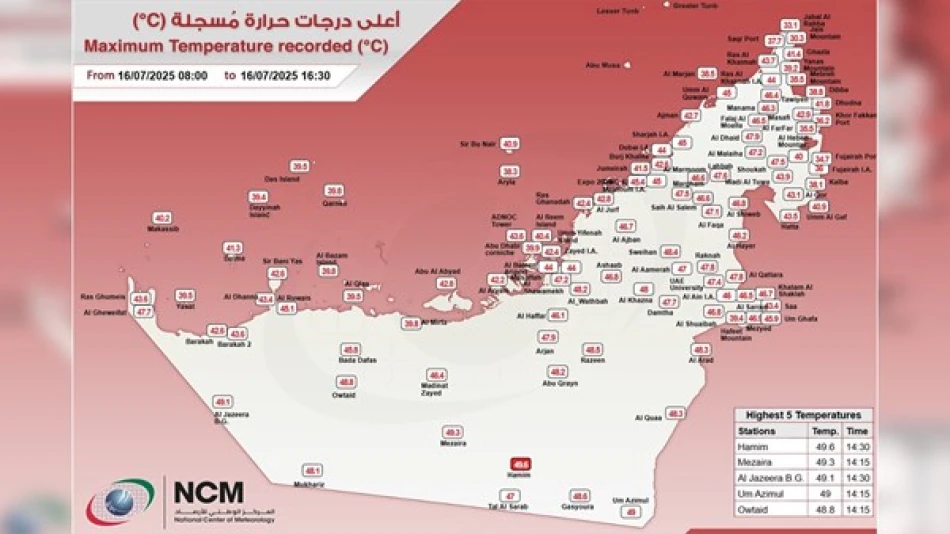
UAE Sizzles at Record-Breaking Temperatures: Extreme Heat Wave Grips the Nation
UAE Hits Scorching 49.6°C as Desert Nation Faces Another Extreme Heat Challenge
The United Arab Emirates recorded a blistering 49.6°C (121.3°F) on Wednesday in the remote desert area of Hamim in Al Dhafra region, highlighting the Gulf nation's ongoing battle with extreme temperatures that test both infrastructure resilience and energy consumption limits. The temperature, measured at 2:30 PM local time, underscores the intensifying heat patterns that have become increasingly common across the Arabian Peninsula.
Al Dhafra: The UAE's Heat Epicenter
Al Dhafra region, located in the western part of Abu Dhabi emirate, has consistently emerged as the UAE's hottest zone during summer months. The area's inland desert location, far from coastal moderating influences, creates perfect conditions for extreme heat accumulation. Hamim, where Wednesday's peak temperature was recorded, sits in one of the most arid sections of the Arabian Desert, where minimal vegetation and vast sand expanses amplify solar radiation effects.
The National Center of Meteorology's precise tracking of these temperatures reflects the UAE's sophisticated weather monitoring infrastructure, developed partly in response to the country's need to manage extreme climate conditions that regularly push above 45°C during summer months.
Economic and Infrastructure Implications
Energy Demand Surge
Such extreme temperatures place enormous strain on the UAE's electrical grid, with air conditioning demand typically spiking during peak afternoon hours. The country's energy consumption can increase by up to 40% during summer months compared to winter, forcing utilities to maintain expensive backup capacity and driving up operational costs across all sectors.
For businesses, particularly those in construction, logistics, and outdoor services, these temperatures create operational challenges that require adjusted working hours, increased safety protocols, and higher insurance costs. Many companies shift to night operations during peak summer months to protect workers and maintain productivity.
Water Security Concerns
Extreme heat accelerates evaporation rates and increases water demand across residential, commercial, and agricultural sectors. The UAE's heavy reliance on energy-intensive desalination becomes even more critical during such periods, creating a cycle where higher temperatures drive both increased energy and water consumption simultaneously.
Regional Context and Global Comparisons
The UAE's 49.6°C reading places it among the world's hottest inhabited regions, comparable to summer temperatures in Death Valley, California, or parts of Iran and Iraq. However, unlike many other extreme heat locations, the UAE maintains year-round economic activity and urban development despite these conditions, largely through massive investments in cooling infrastructure and adaptive urban planning.
Neighboring Gulf states face similar challenges, with Saudi Arabia, Kuwait, and Qatar regularly recording temperatures above 48°C. The difference lies in the UAE's economic diversification strategy, which has created heat-resilient sectors like finance, technology, and indoor entertainment that can operate regardless of external temperatures.
Climate Adaptation as Competitive Advantage
Rather than viewing extreme heat as purely problematic, the UAE has positioned its climate resilience as a competitive advantage. The country's expertise in desert agriculture, cooling technologies, and heat-resistant construction has become exportable knowledge, particularly valuable as global temperatures rise and more regions face similar challenges.
The UAE's hosting of COP28 climate talks in 2023 partly leveraged this positioning – presenting the nation as uniquely qualified to address climate adaptation challenges through practical experience rather than theoretical planning.
Looking Ahead: Heat as the New Normal
Wednesday's 49.6°C temperature, while extreme, represents the type of heat that climate models predict will become increasingly common across the Gulf region. The UAE's response – continued investment in renewable energy, smart city technologies, and climate-controlled environments – offers a preview of how desert nations might adapt to a warming world.
For investors and policymakers globally, the UAE's approach demonstrates that extreme heat, while challenging, need not halt economic development if sufficient resources are dedicated to adaptation infrastructure. The question remains whether this capital-intensive model can be replicated in regions with fewer financial resources but similar climate pressures.
Most Viewed News

 Layla Al Mansoori
Layla Al Mansoori






